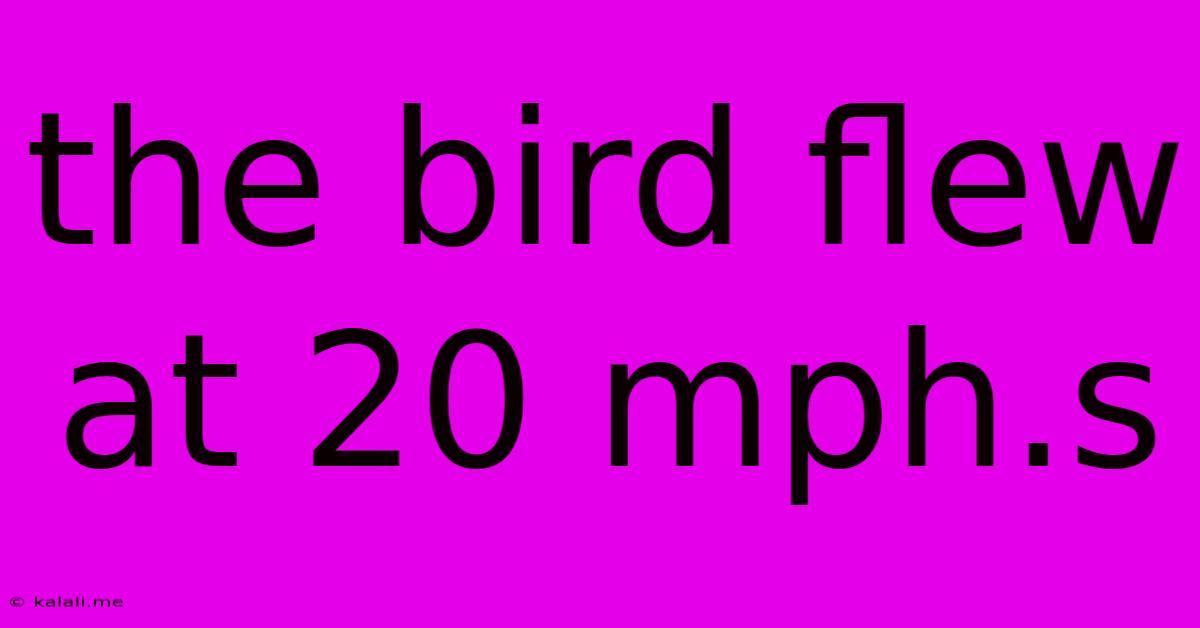The Bird Flew At 20 Mph.s
Kalali
Jun 02, 2025 · 3 min read

Table of Contents
Decoding the Flight Speed: When a Bird Flies at 20 mph
This article delves into the fascinating world of avian flight speed, specifically focusing on the implications of a bird flying at 20 mph (miles per hour). While a simple statement, "the bird flew at 20 mph," opens up a world of questions about bird species, flight mechanics, and the environmental factors influencing speed. Understanding this seemingly straightforward statement requires a deeper dive into the complexities of ornithology.
What Bird Could Fly at 20 mph?
20 mph isn't an exceptionally fast or slow speed for a bird. Many common species can easily achieve or exceed this speed during different phases of flight. For instance, smaller birds like robins or sparrows might reach this speed during short bursts of energy, perhaps escaping a predator or pursuing prey. Larger birds, such as pigeons or crows, might maintain a cruising speed around 20 mph during their regular flights. Migratory birds, known for their long-distance travels, often achieve significantly higher speeds, but 20 mph could be a typical speed during less strenuous parts of their journey. The type of bird greatly influences its flight speed capabilities. Factors like wingspan, body mass, and wing shape all play crucial roles.
Factors Affecting Bird Flight Speed
Several environmental and physiological factors influence a bird's flight speed. These include:
- Wind: Tailwinds can significantly boost a bird's speed, while headwinds act as resistance, slowing it down. 20 mph in a headwind might represent a much faster ground speed for the bird.
- Altitude: Air density changes with altitude, affecting lift and drag. Higher altitudes might require more effort to maintain the same speed.
- Body condition: A bird's health, age, and energy reserves affect its flight performance. A tired or injured bird would likely fly at a slower speed.
- Type of flight: Birds use different flight styles depending on their needs – soaring, flapping, gliding. Each style impacts speed and energy expenditure. A bird might maintain 20 mph while gliding but need to flap its wings faster to achieve the same speed against a strong wind.
- Bird species: As mentioned earlier, different species have different inherent flight capabilities. Swifts, known for their speed, would far exceed 20 mph, while some heavier birds might struggle to reach it.
Beyond the Simple Statement: Researching Avian Flight
The statement "the bird flew at 20 mph" is a starting point for a much richer understanding of avian flight dynamics. Researchers use various technologies, including radar and GPS tracking, to study bird migration patterns and flight speeds. This data provides invaluable insights into bird behavior, ecology, and conservation efforts. By examining speed data in conjunction with other variables such as altitude, wind speed, and species, scientists can unravel the intricate mechanisms behind bird flight. Analyzing these data points allows for a better understanding of how birds adapt to their environment and the challenges they face.
Conclusion: Unpacking the Significance of Flight Speed
The simple statement about a bird's speed at 20 mph invites a deeper exploration of the complex world of avian flight. The speed itself is only one piece of the puzzle, providing a glimpse into the intricate interplay between bird physiology, environmental conditions, and behavioral adaptations. Further investigation into these factors unveils a fascinating story of natural selection and survival.
Latest Posts
Latest Posts
-
Who Says Capns Log In Star Trek Tng
Jun 04, 2025
-
Which Side Is Hot And Cold On A Faucet
Jun 04, 2025
-
How To Get Shovel In Animal Crossing
Jun 04, 2025
-
How Much Coffee For 4 Cups Of Coffee
Jun 04, 2025
-
What Is The Red Wire On A Ceiling Fan
Jun 04, 2025
Related Post
Thank you for visiting our website which covers about The Bird Flew At 20 Mph.s . We hope the information provided has been useful to you. Feel free to contact us if you have any questions or need further assistance. See you next time and don't miss to bookmark.